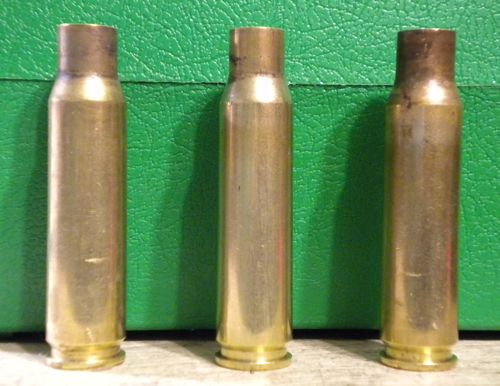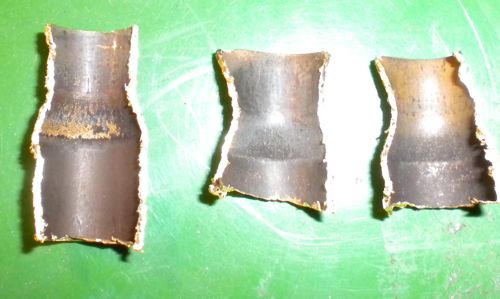I've decided to add case annealing to my reloading routine & have a few questions. I picked up the Hornady kit for starters, and I had done enough reading on the subject to believe that the results I would get by using the behavior of the ~450 degree Tempilaq per the instructions included in the kit would be inadequate. Attached are images of samples of separate runs of 10 cases I did with slight variations in technique. The cases were identical Federal brass from my discards with 6 firings on them. The constants throughout the 3 trials were the size of the flame, the speed of rotation, and the position of the case in the flame with the case mouth held just inside the tip of the inner flame. The cases were quenched in water. I've constructed a stand for the torch that puts the flame level with the case mouth with the flat base of the cordless drill I'm using resting on the same surface as the stand.
The one on the left was marked just below the shoulder as per the instructions included with the kit. It took roughly 5 seconds for the marker to melt. Inspection of the inner surface of the neck reveals no discoloration. The second sample was marked at a distance below the shoulder roughly equal to the length of the neck. It took roughly 10 seconds to activate the marker. Inspection of the inner neck shows an area of discoloration right below the case mouth, extending no more than .125" or so on any of the cases. The third sample was marked halfway down the body of the case, and held in the flame for 15 seconds. This did not activate the Tempilaq. The portion of the case in direct contact with the flame began glowing a very dull red immediately prior to the time expiring. Inspection of the inner neck area showed discoloration similar to that in Sample 2 extending the full length of the neck.
It's my belief that Sample 3 represents the results that I'm looking for, but I'd like the opinion of some more experienced shooters before I shift into production mode. Thanks in advance for sharing your wisdom.


The one on the left was marked just below the shoulder as per the instructions included with the kit. It took roughly 5 seconds for the marker to melt. Inspection of the inner surface of the neck reveals no discoloration. The second sample was marked at a distance below the shoulder roughly equal to the length of the neck. It took roughly 10 seconds to activate the marker. Inspection of the inner neck shows an area of discoloration right below the case mouth, extending no more than .125" or so on any of the cases. The third sample was marked halfway down the body of the case, and held in the flame for 15 seconds. This did not activate the Tempilaq. The portion of the case in direct contact with the flame began glowing a very dull red immediately prior to the time expiring. Inspection of the inner neck area showed discoloration similar to that in Sample 2 extending the full length of the neck.
It's my belief that Sample 3 represents the results that I'm looking for, but I'd like the opinion of some more experienced shooters before I shift into production mode. Thanks in advance for sharing your wisdom.






